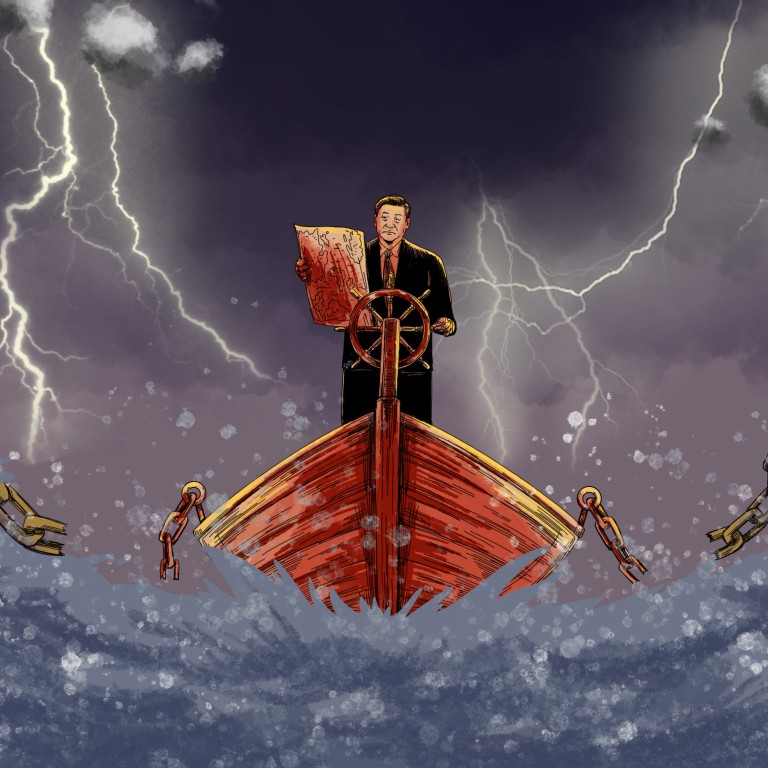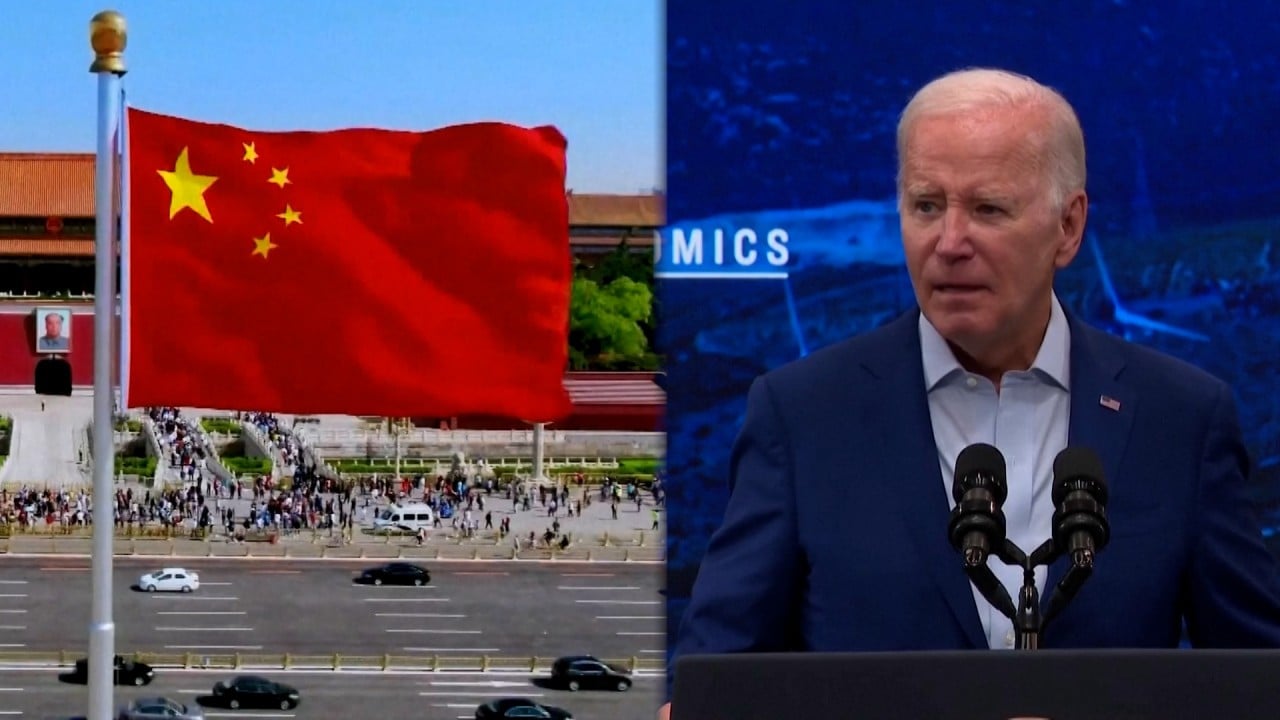
With Xi Jinping facing challenges on multiple fronts, can China’s helmsman navigate through stormy seas?
- Xi Jinping began an unprecedented third term as China’s president in March, vowing to navigate risks, having received unanimous support from the national legislature
- But China’s norm-breaking president is facing increased competition with the US on the world stage, and a struggling domestic economy at home
When President Xi Jinping gave his speech before kicking off his norm-breaking third term in March, he vowed to lead China through a “turbulent decade” and to sail the country through “dangerous storms” ahead.
On the international front, China has been engaged in an all-encompassing competition with the United States in areas from trade and tech to security.
This has spilled over to having other developed economies call for so-called de-risking in their supply chains, further hindering China’s aim to become a top global exporter and tech power.
Xi is facing challenges on multiple fronts, and they are interconnected
This all could, analysts said, culminate in a defining moment for Xi. Hailed as China’s “helmsman” and “navigator” by state media and his political aides, Xi has a chance to shape his legacy during another five-year term.
“Xi is facing challenges on multiple fronts, and they are interconnected,” said Yeling Tan, a Chinese politics professor at the University of Oregon.
“US-China competition raises business risks and therefore weakens economic prospects, while national security challenges also require policymakers to balance security and economic considerations rather than focusing their full attention on any single priority, such as economic recovery.”
China has faced a series of tech and economic sanctions from the US on the grounds of “national security”, with Beijing perceiving Washington’s moves as efforts intended to hurt its development.
Biden’s executive order added to a long list of recent moves by Washington, including export controls on China’s access to critical materials, barring Americans from working in China’s advanced chips development industry, and teaming up with allies to create their own supply chains.
China wanted to, according to a goal first proposed by Xi in 2016 during his first term, become the “top world power” in science and technology innovation by 2030.
Xi has placed an emphasis on self-reliance in scientific and technological advancements, but observers have said its technology and talent in cutting edge technology still largely lags behind the US despite state financing.
The experts, including those focused on artificial intelligence and superconductors, are expected to “make new and greater contributions to achieving high-level scientific and technological self-reliance,” according to Cai Qi, President Xi’s chief of staff.
Richard McGregor, a senior fellow for East Asia at the Lowy Institute, said technology being one of the areas “at the heart of China’s plans to become the dominant power in the region” means Xi’s personal standing could be hurt if there is “a lengthy period of sub-par growth” in the economy, which needs to finance its development.
How high will the fence be? China’s grave concerns over US tech investment curbs
Closer to home, the big question in front of Xi is whether he can find a way to address structural problems in China, analysts said.
“The heart of the problem is that China’s development model doesn’t work any more”, said George Magnus, an economist at Oxford University’s China Centre.
But Beijing does not appear to have “the political will” to embrace structural changes necessary, according to Magnus.
For Alfredo Montufar-Helu, head of the China Centre for Economics and Business at The Conference Board, a lack of a strong social security net and unequal access to quality healthcare and education services, as well as a regional and urban-rural development divide, represent a series of structural imbalances.
Authorities will have to balance this with providing support to the supply-side economy through stimulus measures
“Addressing these imbalances will take time, and the problem is that authorities will have to balance this with providing support to the supply-side economy through stimulus measures,” Montufar-Helu said.
Magnus added that there is also the need for structural changes in local government financing and governance affecting private firms and entrepreneurs.
Earlier this month, the official journal of the Communist Party published a speech from Xi that called for “patience and resilience” in the pursuit of “the national rejuvenation”.
China’s ticking debt dilemma: the longer they wait, the bigger the cost
“We should first consider the size of the population and the large rural-urban development gap. We cannot be ambitious and unrealistic, but we cannot simply follow the beaten path,” Xi said.
“We should be patient [with a historical perspective] and move forward in a steadfast manner.”
However, patience has been running out as international banks and institutions have lowered their forecasts for China’s economic growth this year, with the economy having lost momentum earlier than expected in the first half of the year.
And while it is generally expected that China will reach its annual GDP growth target of “around 5 per cent”, the major drivers of the economy – exports, foreign direct investment and land sales- have all been declining
No turnaround, jobless rates halted: 7 takeaways from China’s July economic data
The Politburo meeting listed challenges including domestic demand, difficulties for business to operate and “complications and difficulties” in the external environment.
“Our economy has enormous development resilience and potential. The long-term positive outlook has not changed,” said a statement from the 24-member Politburo – the Communist Party’s prime decision-making body.
Looking forward, China’s leadership has long focused on its development strategy to move away from economic growth targets and towards systemic resilience by calling for a drive for an “internal cycle” in the five-year plan to 2025.
‘All-round development’ a must as China balances Xi’s high-quality growth goal
China previously included a goal to lift itself into a “high income” nation by 2025 and advance to a “moderately developed” nation by 2035, which implies income of more than US$20,000 per person. China’s per capita GDP is around US$12,000, according to official data.
And despite the current slump in a wide-range of economic indicators, Yu Miaojie, an economist who is also the president of Liaoning University, said he is confident that China would be able to reach its target.
“Right now, China’s potential in being a mega-size economy and the ability to complete a full supply chain have not even been fully unleashed. With further structural reforms, it is not a problem in achieving a GDP growth of 4.5 to 5 per cent in the coming years, which would help us reach this target,” said Yu, who is also a chair professor of economics at Peking University.
By 2035, China is also expected to become a “manufacturing superpower” and a global leader in strategically important emerging industries.
However, even China’s traditional role as the world’s leading manufacturer, exporter and top investment destination faces challenges as geopolitical tensions grow.
The US and its allies are calling to de-risk their supply chains away from China to reduce reliance, while the list of export controls against Chinese companies due to security concerns has been expanded.
China’s exports to remain weak until 2024: 4 takeaways from July’s trade data
Xi can still grow the economy with statist and more security-focused policies, just not as much as if he leaned further into building more open and efficient markets
Neil Thomas, a Chinese politics fellow at the Asia Society Policy Institute’s Centre for China Analysis, said Xi faces a balancing act between economic growth and national security.
“Xi can still grow the economy with statist and more security-focused policies, just not as much as if he leaned further into building more open and efficient markets,” said Thomas.
But for Xi, tighter control over society and the economy appear necessary despite its costs, according to Lee Jong-hyuk, an assistant professor in the China Programme at Nanyang Technological University in Singapore.
To Xi Jinping, national security holds paramount importance over national and domestic security as it directly impacts his survival as a leader
“To Xi Jinping, national security holds paramount importance over national and domestic security as it directly impacts his survival as a leader,” said Lee.
But despite some analysts saying that Xi does not appear to be facing a crisis moment despite current challenges, China’s competition with the US will now take place in direct comparison as its economic rebound has recovered better than expected.
GDP growth in the US in the second quarter is expected to be 2.4 per cent, up from 2 per cent in the first three months of the year, according to the US Department of Commerce, as inflation is cooling and its unemployment rate is close to its lowest level in 40 years.
In a closed-door economic academic seminar in July, Chinese economists said they were surprised to see the US recovery holding up.
“The US has shown resilience in its economy so far,” a Beijing-based economist said.
“If we put this in a longer timeline … what if [the US] successfully controls its inflation, can we really say their potential growth is going down?”
The world’s two largest economies have already been fighting for economic supremacy with a tit-for-tat trade war, US-led supply chain decoupling and tech containment in the past five years.
Domestic academics have largely estimated that China will overtake the US to become the world’s largest economy around 2030, but its weak recovery has raised speculation overseas that it may never happen, just like the former Soviet Union in the 1970s and Japan in the 1980s.
Economic aspiration is essential to stable social relations, especially when citizens, as in China, are unable to determine who governs them or for how long
Xi has built his vision for China on the concept of national rejuvenation on two pillars, namely unification with Taiwan and a strong economy that would bring it “eye to eye” with the US on the international stage.
But despite competition with the US being one of Xi’s “biggest foreign policy headaches”, the economy is still the most imminent problem at home, as it could have a ripple effect that would be long-lasting, Magnus said at Oxford University’s China Centre.
“Economic aspiration is essential to stable social relations, especially when citizens, as in China, are unable to determine who governs them or for how long,” he said.
“If the government isn’t able or willing to prosecute important reforms to macro economic management and political governance, China’s economy faces a challenging and most likely disappointing period ahead, which will undercut China’s status to some extent in international relations and in the global economy.”




